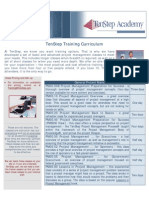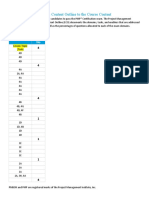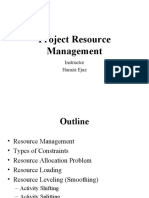Mm1 Scrum Poster A0
Mm1 Scrum Poster A0
Uploaded by
upendrasCopyright:
Available Formats
Mm1 Scrum Poster A0
Mm1 Scrum Poster A0
Uploaded by
upendrasOriginal Description:
Copyright
Available Formats
Share this document
Did you find this document useful?
Is this content inappropriate?
Copyright:
Available Formats
Mm1 Scrum Poster A0
Mm1 Scrum Poster A0
Uploaded by
upendrasCopyright:
Available Formats
Scrum
according to m
Roles
Product owner: the person responsible for maintaining the product backlog by
representing the interests of the stakeholders, ensuring the value of the work the
Sprint
Increment
Product
development team does.
Scrum master: the person responsible for the scrum process, making sure it is
used correctly and maximizing its benefits. Although the designation of a scrum
ye
master and its presence in scrum meetings is generally advisable, teams with a lot
Potentially
shippable
product
of scrum experience may also work without this role.
Development team: a cross-functional group of people responsible for delivering
potentially shippable increments of the product at the end of every sprint.
Stakeholders: the people enabling the project. They are only directly involved in
the process during the reviews. Aside from that, they may solely influence the
team by discussing their needs with the product owner. Typically, the main
t
e
y
t
o
n
Product
Owner
stakeholders are managers, customers and users.
Mission
achieved?
Sprint Review
Artifacts
( )
Product backlog: an ordered list of requirements that the team maintains for a
product. In Scrum, one should document requirements in user story format.
Anyone can edit the backlog, but the product owner is ultimately responsible for
ordering the user stories. Stories in the product backlog contain rough estimates
of both business value and development effort.
Sprint backlog: a list of work the development team must address during the
next sprint. The list is created by selecting user stories from the top of the
product backlog until the development team feels it has enough work to fill the
sprint, keeping in mind the velocity of its previous sprints. The stories/features are
broken down into tasks by the development team. Often an accompanying task
board is used to see and change the state of the tasks of the current sprint, like
to do, in progress and done.
Idea
User story: a description of a certain product feature or behavior, written strictly
from the users point of view. Usually, the product owner writes the user stories.
Task: a unit of work, which should be feasible within one working day or less.
To implement a user story, you must accomplish all associated tasks.
Sprint Retrospective
Burn down charts: are publicly displayed charts showing invested and
25
20
remaining work. The team uses sprint burn down charts to visualize the progress
15
10
0
1
within a sprint. Release burn down charts show the amount of work left to
complete the target commitment for a product release.
Impediment backlog: a list of current impediments maintained by the
scrum master.
Definition of done: a checklist of activities required to declare the
( )
Product
Backlog
User Stories
Daily Scrum Meeting
Taskboard (to do, in progress, done)
Impediment Backlog
Burndown Chart
Scrum
Master
Team
Sprint Planning 1&2
beginning of the project but the team can change it at any time.
Meetings
Sprint planning 1: (60 min per sprint week) is held to select the work to be done
for the next sprint (the what). The product owner explains the stories of the
product backlog to the team and answers their question. After the planning,
the team should have understood the requirements and its commits the scope for
the sprint.
Sprint planning 2: (60 min per sprint week) the designing phase for the
selected backlog (the how). The team discusses a solution for the selected
stories and creates according task for each story.
Daily scrum: (ca. 15 min) short, time boxed meeting, every day at the same time.
Every team member answers three questions:
1) What have I done since yesterday?
25
Product
Owner
implementation of a story to be completed. The definition is determined at the
2) What am I planning to do today?
20
3) What are my impediments?
15
Sprint review: (ca. 60 min per sprint week) used to present and review the work
that was completed and not completed during a sprint. It should include a
10
demonstration of the realized product increment.
Sprint retrospective: (ca. 45 min per sprint week) a reflection on the past sprint
used to make continuous process improvements. Two main questions are asked in
0
1
the sprint retrospective:
1) What went well during the sprint?
2) What could be improved in the next sprint?
Estimation meeting: (max. 60 min) used to introduce and estimate new backlog
items and to refine existing estimations as well as acceptance criteria. It is also
used to break large stories into smaller ones.
t
n
i
r
p
S
2. How?
You may freely copy and distribute this poster, but you must not modify it. NOT FOR SALE OR RESALE.
Sprint Backlog DoD
V 2.0
1. What?
mm1 Consulting & Management
Consulting in Innovation & Transformation.
Believing in Design Thinking, Lean Thinking, and Agile Doing.
Contact us: agile@mm1-consulting.com
www.mm1-consulting.com
You might also like
- PMP Cheat Sheet PDFDocument1 pagePMP Cheat Sheet PDFthouartu78% (37)
- Agile Project Management With KanbanDocument10 pagesAgile Project Management With KanbanAbrahan BVNo ratings yet
- PMI Portfolio Management Professional (PFMP) Certification Experience - LinkedInDocument4 pagesPMI Portfolio Management Professional (PFMP) Certification Experience - LinkedInxiaohaisuNo ratings yet
- Balancing Continuous Discovery and Delivery Jeff PattonDocument121 pagesBalancing Continuous Discovery and Delivery Jeff PattonMarcio CunhaNo ratings yet
- Assignmt 1 Group 6 PDFDocument22 pagesAssignmt 1 Group 6 PDFHEMACNo ratings yet
- An Intro To MAHD Ebook Final 7 - 25 - 18Document18 pagesAn Intro To MAHD Ebook Final 7 - 25 - 18Srinivasan VenkatNo ratings yet
- It Health Check Report TemplateDocument3 pagesIt Health Check Report TemplateELias ELNo ratings yet
- Mm1 Scrumban Poster A3Document2 pagesMm1 Scrumban Poster A3tatoandy100% (1)
- Agile NotesDocument109 pagesAgile Noteschhaya100% (1)
- Sprint-Report (Sprint-9-10) - Apr1-2023Document5 pagesSprint-Report (Sprint-9-10) - Apr1-2023Mohammad Hossain100% (1)
- Scrum AirplanesDocument16 pagesScrum AirplanesjeyaganeshnNo ratings yet
- PMO- CP - V1 -25-10-2024Document19 pagesPMO- CP - V1 -25-10-2024ahmedayman181995No ratings yet
- Agile Roles and Agile CeremoniesDocument43 pagesAgile Roles and Agile CeremoniesFrau CarolinaNo ratings yet
- 18 Plans & 33 DocuemtnsDocument4 pages18 Plans & 33 Docuemtnsku385521No ratings yet
- Immediate Download Head First Agile A Brain Friendly Guide To Agile and The PMI ACP Certification 1st Edition Andrew Stellman Ebooks 2024Document62 pagesImmediate Download Head First Agile A Brain Friendly Guide To Agile and The PMI ACP Certification 1st Edition Andrew Stellman Ebooks 2024thuransippl100% (4)
- Agile Q1Document12 pagesAgile Q1ursmahipalNo ratings yet
- SH QuestionsDocument21 pagesSH QuestionsJoseph Kwafo MensahNo ratings yet
- Change Management in IbmDocument13 pagesChange Management in IbmkarabimalakarNo ratings yet
- An Introduction To: Agile Methodologies: SCRUM and XPDocument33 pagesAn Introduction To: Agile Methodologies: SCRUM and XPAmit SinhaNo ratings yet
- Alvin The PM Cheatsheet - Project Life Cycles ExDocument2 pagesAlvin The PM Cheatsheet - Project Life Cycles ExmohamedremNo ratings yet
- Questions 1 - AnswersDocument51 pagesQuestions 1 - AnswersMutazALqawasmi100% (1)
- Agile SummaryDocument6 pagesAgile SummaryAli AsgharNo ratings yet
- Third Quiz of MGt503 16-12-2011Document10 pagesThird Quiz of MGt503 16-12-2011AliImranNo ratings yet
- Pmp-Exam-Prep-T90 9Document8 pagesPmp-Exam-Prep-T90 9CataNo ratings yet
- Alistair Cockburn SCRUMDocument143 pagesAlistair Cockburn SCRUMACP100% (1)
- PMP Processes Pmbokv4.0Document32 pagesPMP Processes Pmbokv4.0asimsquareNo ratings yet
- PMP Ten Step TrainingDocument5 pagesPMP Ten Step Trainingdesignurbain0% (1)
- Glossary of Project Management - WikipediaDocument11 pagesGlossary of Project Management - Wikipediafpttmm100% (1)
- Pmi AcpDocument33 pagesPmi AcptobyhungwcNo ratings yet
- Agile Methodology ScrumDocument21 pagesAgile Methodology ScrumAhmad JavedNo ratings yet
- PMBOK 6th Edition SummaryDocument171 pagesPMBOK 6th Edition SummaryAdil IqbalNo ratings yet
- Covered In: Mapping The PMP® Exam Content Outline To The Course ContentDocument8 pagesCovered In: Mapping The PMP® Exam Content Outline To The Course ContentMoEllitheyNo ratings yet
- Agile Scrum Foundation EXIN 2014 227 Q + A PDFDocument61 pagesAgile Scrum Foundation EXIN 2014 227 Q + A PDFManish0% (1)
- Professional Practices: "Anatomy of A Software House"Document20 pagesProfessional Practices: "Anatomy of A Software House"raahim majid100% (1)
- PMP Study Guide: Chapter 1: What Is A Project?Document40 pagesPMP Study Guide: Chapter 1: What Is A Project?hardikNo ratings yet
- Craig Huxley Thesis PDFDocument366 pagesCraig Huxley Thesis PDFWayan Golgol NapitupuluNo ratings yet
- PMP PreparationDocument2 pagesPMP Preparationaaradhana345No ratings yet
- Qvive PMP Formulas PMBOK6 v1bDocument1 pageQvive PMP Formulas PMBOK6 v1bObi A AgusioboNo ratings yet
- Primavera P6 Enterprise Project Portfolio ManagementDocument4 pagesPrimavera P6 Enterprise Project Portfolio ManagementMehdi MehdizadeNo ratings yet
- OpenText RightFax 10.6 FP2 COM API Reference GuideDocument139 pagesOpenText RightFax 10.6 FP2 COM API Reference GuideRodrigo CardosoNo ratings yet
- 47 Project Processes Input - Output - SummaryDocument10 pages47 Project Processes Input - Output - Summaryjimbox88No ratings yet
- PMP Terms-NotesDocument39 pagesPMP Terms-NotesPanneerselvam EkNo ratings yet
- PM620 Unit 4 DBDocument3 pagesPM620 Unit 4 DBmikeNo ratings yet
- PMP Chapter 1 - 1Document13 pagesPMP Chapter 1 - 1aminNo ratings yet
- PMBOK T&T Chapter 9Document1 pagePMBOK T&T Chapter 9EmmaNo ratings yet
- PMP Tools and Tech FinalDocument20 pagesPMP Tools and Tech FinalShishan Ahmad100% (1)
- Chap 2 Software Project ManagementDocument49 pagesChap 2 Software Project Managementmigad100% (1)
- Waterfall Agile Dotvoting Group Queue - Role Planningpoker Tacit Batch Crystal CSM WSJF PBI Story Sprint WIP Atdd Last Project Kanban Invest ScrumDocument1 pageWaterfall Agile Dotvoting Group Queue - Role Planningpoker Tacit Batch Crystal CSM WSJF PBI Story Sprint WIP Atdd Last Project Kanban Invest ScrumvictorNo ratings yet
- Guia Estudio PDFDocument72 pagesGuia Estudio PDFErika GuzmanNo ratings yet
- Falcon Training PMI ACP Day1 Presentation WebsiteDocument88 pagesFalcon Training PMI ACP Day1 Presentation Websitemhamrawy100% (2)
- Professional Cloud DevOps Engineer - enDocument33 pagesProfessional Cloud DevOps Engineer - enSimon Yeswa MukavanaNo ratings yet
- Project Resource Management: Instructor Hamza EjazDocument19 pagesProject Resource Management: Instructor Hamza EjazShaheena SanaNo ratings yet
- Portfolio Stepe BookDocument318 pagesPortfolio Stepe BookElizabeth RojasNo ratings yet
- RFP - Portfolio Management Profession Training - v1.0Document4 pagesRFP - Portfolio Management Profession Training - v1.0Nacib MeftahNo ratings yet
- Service Operations Management Improving Service Delivery 4th Edition Robert Johnson 2024 Scribd DownloadDocument84 pagesService Operations Management Improving Service Delivery 4th Edition Robert Johnson 2024 Scribd Downloaddjelngouin100% (2)
- Learn How To Set Up and Run A Project Management Office: A Tenstep White PaperDocument16 pagesLearn How To Set Up and Run A Project Management Office: A Tenstep White PaperMoradNo ratings yet
- Or Distribute: PMI Authorized PMP Exam Prep CourseDocument14 pagesOr Distribute: PMI Authorized PMP Exam Prep CourseSamuel ToriolaNo ratings yet
- Phase 4 - Project Management Financial Assessments Value in Using PERT, Risk Matrices, and Earned Value Management Memo Joseph M. Rivard Professor: Dr. Gonzalez PM620-1003B-01 September 10, 2010Document5 pagesPhase 4 - Project Management Financial Assessments Value in Using PERT, Risk Matrices, and Earned Value Management Memo Joseph M. Rivard Professor: Dr. Gonzalez PM620-1003B-01 September 10, 2010jojolax36No ratings yet
- Project Management Professional PMP FormulasDocument4 pagesProject Management Professional PMP FormulassachingandhiNo ratings yet
- Paper 2 - Criteria For Selecting Software Development ModelsDocument6 pagesPaper 2 - Criteria For Selecting Software Development ModelsAndi MozartNo ratings yet
- Top 18 Kanban Interview QuestionsDocument5 pagesTop 18 Kanban Interview Questionspexoj69013No ratings yet
- Mm1 Scrum Poster A3Document2 pagesMm1 Scrum Poster A3mobarmgNo ratings yet
- Agile MethodolgyDocument43 pagesAgile MethodolgySriramachandra NagubandiNo ratings yet
- PMP CheatSheetDocument1 pagePMP CheatSheetalfri121No ratings yet
- Tips For Memorizing IttosDocument4 pagesTips For Memorizing IttosRobincrusoe100% (3)
- Pmptrainingsigmora 150304062910 Conversion Gate01Document95 pagesPmptrainingsigmora 150304062910 Conversion Gate01upendrasNo ratings yet
- Calculating Critical Path & Float For A Network Diagram: Task Name, Duration (D)Document6 pagesCalculating Critical Path & Float For A Network Diagram: Task Name, Duration (D)Kim LongNo ratings yet
- Ospmp5 PDFDocument6 pagesOspmp5 PDFupendrasNo ratings yet
- Webinar Presentation PMP - Time ManagementDocument10 pagesWebinar Presentation PMP - Time Managementupendras100% (1)
- PMP Exam Formula Practice SheetDocument1 pagePMP Exam Formula Practice SheetupendrasNo ratings yet
- Diane Hayes PaperDocument48 pagesDiane Hayes PaperupendrasNo ratings yet
- BridgingMinds PMP Examination PrepDocument2 pagesBridgingMinds PMP Examination PrepupendrasNo ratings yet
- PMP Exam FormulasDocument1 pagePMP Exam FormulasupendrasNo ratings yet
- Project Execution, Monitoring and Control: Figure 1.PDCA CycleDocument18 pagesProject Execution, Monitoring and Control: Figure 1.PDCA CycleupendrasNo ratings yet
- Pmo Framework and Pmo Models For Project Business ManagementDocument22 pagesPmo Framework and Pmo Models For Project Business Managementupendras100% (1)
- 10 Risk Review ProcessDocument67 pages10 Risk Review ProcessupendrasNo ratings yet
- Module 10 Procurement ManagementDocument21 pagesModule 10 Procurement ManagementupendrasNo ratings yet
- SDLC AssignmentDocument51 pagesSDLC AssignmentSabin pokhrelNo ratings yet
- Full Delivery Life Cycles – Disciplined Agile (DA)Document6 pagesFull Delivery Life Cycles – Disciplined Agile (DA)srnssnsamNo ratings yet
- Software Engineering (CSI 321) : Process ModelsDocument40 pagesSoftware Engineering (CSI 321) : Process ModelsJagadeesh MohanNo ratings yet
- Scrum: An IntroductionDocument26 pagesScrum: An IntroductionManisha RathaurNo ratings yet
- System Investigati ON System Analysis Maintanen CE: G. Raja Sekhar 1Document23 pagesSystem Investigati ON System Analysis Maintanen CE: G. Raja Sekhar 1Jayanthi VaniNo ratings yet
- Form 03 QuestionsDocument6 pagesForm 03 QuestionsMagomed KitaevNo ratings yet
- DevOps Culture Q&ADocument3 pagesDevOps Culture Q&APriti Sharma67% (3)
- ITGov S7 SCRUM-DEVOPS Template 2020IDocument34 pagesITGov S7 SCRUM-DEVOPS Template 2020IJose BryanNo ratings yet
- Evaluarea Costului Unui Soft - ExempleDocument5 pagesEvaluarea Costului Unui Soft - ExempleVadim CiubotaruNo ratings yet
- Waterfall Methodology: OverviewDocument9 pagesWaterfall Methodology: OverviewjanematthewNo ratings yet
- Software Development Models U4 PDFDocument81 pagesSoftware Development Models U4 PDFDavindran Kumaar AnanthanNo ratings yet
- UNIT-1: 1. Discuss The Advantages & Disadvantages of Agile Method?Document65 pagesUNIT-1: 1. Discuss The Advantages & Disadvantages of Agile Method?Shuchita MishraNo ratings yet
- Devops and CICDDocument36 pagesDevops and CICDshivasudhakar100% (1)
- Core Scrum Agile AtlasDocument11 pagesCore Scrum Agile AtlasSai KrishnaNo ratings yet
- Scrum 2 Scrumban PDFDocument1 pageScrum 2 Scrumban PDFJoao N Da Silva0% (1)
- ICONIX Is A Software Development Methodology Which Predates Both TheDocument2 pagesICONIX Is A Software Development Methodology Which Predates Both Theyongt9412No ratings yet
- Next Generation Process Essential Modeling: Ivar JacobsonDocument36 pagesNext Generation Process Essential Modeling: Ivar JacobsonChk TsangNo ratings yet
- Full - Final - Development That - Pays - Review PDFDocument9 pagesFull - Final - Development That - Pays - Review PDFManishNo ratings yet
- Use Case Examples - Effective Samples and TipsDocument7 pagesUse Case Examples - Effective Samples and Tipsmetal76No ratings yet
- Agile For Project ManagementDocument15 pagesAgile For Project ManagementsungrayNo ratings yet
- SoftwareDevelopmentLifecycles (SDLCS)Document59 pagesSoftwareDevelopmentLifecycles (SDLCS)geongeoNo ratings yet
- Course Code: (CSI-621) Bioinformatics Software Development II 3 (1-2) by Hafiza Mahwash Faryad Email: 14msishfaryad@seecs - Edu.pkDocument8 pagesCourse Code: (CSI-621) Bioinformatics Software Development II 3 (1-2) by Hafiza Mahwash Faryad Email: 14msishfaryad@seecs - Edu.pkMavra KhalidNo ratings yet
- JPW KSK3014Document4 pagesJPW KSK3014HadiJohariNo ratings yet
- SDLC ModelsDocument31 pagesSDLC ModelsSandesh AhirNo ratings yet
- S.no QuestionsDocument9 pagesS.no Questionsuttam.niftNo ratings yet
- Agile Working in A Nutshell EngDocument2 pagesAgile Working in A Nutshell EngMiguel AngelNo ratings yet







































































































